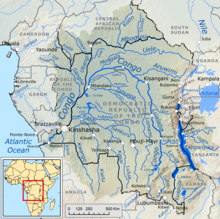കോംഗോ നദി
ലോകത്തിലെ ഏറ്റവും ആഴമേറിയ നദിയാണ് കോംഗോ നദി.
പടിഞ്ഞാറൻ മദ്ധ്യ ആഫ്രിക്കയിലെ ഏറ്റവും വലിയ നദിയാണ് കോംഗോ നദി( Congo River Kongo: Nzâdi Kôngo, French: Fleuve Congo, പോർച്ചുഗീസ്: Rio Congo),. സയർ നദി എന്നും അറിയപ്പെടുന്നു. 4,700 കിലോമീറ്റർ (2,922 മൈൽ) നീളമുള്ള കോംഗോ നൈലിന് പിന്നിലായി ആഫ്രിക്കയിലെ ഏറ്റവും നീളമേറിയ രണ്ടാമത്തെ നദിയാണ്. ആകെ ജലപ്രവാഹത്തിന്റെ കാര്യത്തിലും നദീതടത്തിന്റെ വിസ്തീർണത്തിന്റെ കാര്യത്തിലും തെക്കേ അമേരിക്കയിലെ ആമസോണിന് പിന്നിലായി രണ്ടാം സ്ഥാനത്താണ് കോംഗോ. നദീ മുഖത്ത് നിലനിന്നിരുന്ന പുരാതന കോംഗോ സാമ്രാജ്യത്തിൽ നിന്നാണ് നദിക്ക് ഈ പേര് ലഭിച്ചത്. ഇതിന്റെ തീരത്ത് സ്ഥിതിചെയ്യുന്ന ഡെമോക്രാറ്റിക് റിപ്പബ്ലിക് ഓഫ് ദ കോംഗോ, റിപ്പബ്ലിക്ക് ഓഫ് ദ കോംഗോ എന്നീ രണ്ട് രാജ്യങ്ങളുടേയും പേരിന്റെ ഉൽപത്തി കോംഗോ നദിയിൽ നിന്നാണ്.ഭൂമദ്ധ്യരേഖയെ രണ്ട് പ്രാവശ്യം മുറിച്ചുകടക്കുന്ന ഒരേയൊരു പ്രമുഖനദിയാണ് കോംഗോ.[2] കോംഗോ നദീതടപ്രദേശത്തിന്റെ വിസ്തൃതിയായ 4,000,000 കി.m2 (1,500,000 ച മൈ), ആഫ്രിക്കയുടെ വിസ്തീർണ്ണത്തിന്റെ 13% വരും.
| Congo River | |
|---|---|
 | |
 The drainage basin of the Congo River | |
| മറ്റ് പേര് (കൾ) | Zaire River |
| Physical characteristics | |
| പ്രധാന സ്രോതസ്സ് | Lualaba River Boyoma Falls |
| നദീമുഖം | അറ്റ്ലാന്റിക് സമുദ്രം |
| നീളം | 4,700 കി.മീ (2,900 മൈ) |
| Discharge | |
| നദീതട പ്രത്യേകതകൾ | |
| നദീതട വിസ്തൃതി | 4,014,500 കി.m2 (4.3212×1013 sq ft)[1] |
പേരിനു പിന്നിൽ
തിരുത്തുകഈ നദിയുടെ തെക്ക് ഭാഗത്തായി നിലനിന്നിരുന്ന പുരാതനമായ കോംഗോ സാമ്രാജ്യത്തിന്റെ പേരിൽ നിന്നാണ് നദിക്ക് ഈ പേര് ലഭിച്ചത്. സാമ്രാജ്യത്തിന്റെ പേരാകട്ടെ പതിനേഴാം നൂറ്റാണ്ടിൽ എസികോംഗോ എന്ന് വിളിക്കപ്പെട്ടിരുന്ന തദ്ദേശവാസികളായ ബാണ്ടു വംശജരുടെ പേരിൽനിന്നും ഉരുത്തിരിഞ്ഞതാണ്.[3] അബ്രഹാം ഓർടേലിയസ് 1564-ൽ നിർമ്മിച്ച ലോക ഭൂപടത്തിൽ കോംഗോ നദീ മുഖത്ത് നിലനിന്നിരുന്ന നഗരത്തെ മാനികോംഗൊ എന്നാണ് സൂചിപ്പിച്ചത്.[4]
നദീതടം
തിരുത്തുകകോംഗോ നദീതടം 4,014,500 ച. �കിലോ�ീ. (1,550,000 ച മൈ)[1] വ്യാപിച്ചുകിടക്കുന്നു, ഇന്ത്യയുടെ വിസ്തൃതിയേക്കാൾ കൂടുതലാണിത്. പതനസ്ഥാനത്ത് അറ്റ്ലാന്റിക് സമുദ്രത്തിലേക്ക് പുറന്തള്ളുന്ന ജലത്തിന്റെ അളവ് 23,000-തൊട്ട് 75,000 cubic metres per second (810,000- തൊട്ട് 2,650,000 cu ft/s), വരേയാണ്, ശരാശരി അളവ്41,000 cubic metres per second (1,400,000 cu ft/s).[1]
അവലംബം
തിരുത്തുക- ↑ 1.0 1.1 1.2 1.3 1.4 1.5 Bossche, J.P. vanden; G. M. Bernacsek (1990). Source Book for the Inland Fishery Resources of Africa, Volume 1. Food and Agriculture Organization of the United Nations. pp. 338–339. ISBN 978-92-5-102983-1. Archived from the original on 2016-04-25. Retrieved 2015-12-27.
- ↑ Forbath, Peter. The River Congo (1979), p. 6. "Not until it crosses the equator will it at last turn away from this misleading course and, describing a remarkable counter-clockwise arc first to the west and then to the southwest, flow back across the equator and on down to the Atlantic.
In this the Congo is exceptional. No other major river in the world crosses the equator even once, let alone twice." - ↑ Anderson, David (2000). Africa's Urban Past. p. 79. ISBN 9780852557617. Archived from the original on 2017-12-22. Retrieved 2017-05-04.
- ↑ Manikongo was properly the title of the kings of Kongo; their capital was at the site of modern M'banza-Kongo, capital of Angola's northwestern Zaire Province. Ortelius had no knowledge of the orography of Africa and drew fictitious courses for its rivers; his Congo upstream of its estuary turns sharply south, flowing through what would correspond to Angola and Botswana.